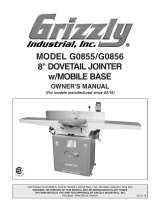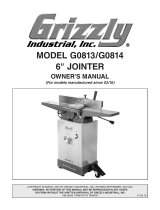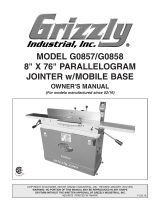
JOINTER PAL
®
KNIFE-SETTING JIG FOR JOINTERS
Preparation
1. DISCONNECT JOINTER FROM POWER!
2. Move the jointer fence all the way to the rear of the jointer table. The fence should
be aligned 90° to the outfeed table. The fences on some of the new jointers auto-
matically align themselves when tightened, but older jointers often employ a “free
floating” fence which should be carefully aligned perpendicular to the outfeed table.
Jointer Pal will work without a fence, but it is much easier to use the fence as a jig
indexing guide when knife changing or shifting.
Finding Top-Dead-Center (TDC)
1. Locate the high point of the cutterhead rotation by placing a straightedge (wood or
metal) on the outfeed table and extending it over the cutterhead. See sketch A at
left.
2. Rock the cutterhead back and forth until the cutting edge of the topmost knife bare-
ly touches the underside of the straightedge. The apex of this arc is at TDC.
Indexing the Fence
1. Leaving the cutterhead at TDC, mark a corresponding spot on the fence using a steel
square and black felt-tip marker. With the steel square in the same position, scribe
(scratch) a heavy vertical line on the fence directly in line with the high point of
rotation of the topmost knife. Use a scribe or any sharp tool that is harder than your
jointer’s fence. See sketch B at left.
2. Place Jointer Pal in position on the outfeed table, flush against the fence, and align
the scribe mark on the Jointer Pal with the scribed line on the fence. The correspond-
ing scribe mark on the Jointer Pal passes directly over the centers of the powerful
permanent magnets at the high point of the cutterhead. With the front scribe mark of
the Jointer Pal aligned with the scribe mark on the fence, mark a corresponding spot
on the fence with the rear scribe mark of the Jointer Pal. See Sketch C at left.
3. Remove Jointer Pal and place a steel square over this mark. Scribe another heavy
vertical line on the fence (see sketch D at left), so you have two heavy vertical lines
on the fence, about 4" apart. With the square in the same location, flip it down flat
on the outfeed table and at a right angle with the fence. Scribe a 90° line across the
outfeed table corresponding exactly with the rear vertical line on the fence.
4. Jointer Pal is shown here (sketch E) in full indexed position with the two scribe lines
in the rear jig body aligned with the corresponding vertical lines on the fence and
horizontal line on the outfeed table. Jointer Pal will now hold your jointer knives
precisely in place while you tighten them in the cutterhead.
Knife Setting
To set the knives, lift the jig off the outfeed table, insert the knife into the cutterhead and
place the jig on the outfeed table with all the scribe marks aligned (see sketch E). Rotate
the cutterhead so the tip of the knife lines up with the scribe mark on the fence. Tighten
the knife in the cutterhead. Repeat for the remaining knives.
Instead of replacing or sharpening nicked knives, you can “shift” them. Simply loosen
the knives in the cutterhead and shift them so the nicks do not overlap. Ensure that the
tip of each knife lines up with the scribe mark on the fence and retighten in the cutter-
head.
Copyright © 1994, Revised July, 2012 (TR) Instructions for Models W1210A, W1211A, W1212A
A
B
C
D
E
/



